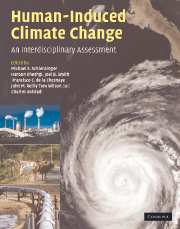Book contents
- Frontmatter
- Contents
- List of contributors
- Preface
- Part I Climate system science
- Part II Impacts and adaptation
- Part III Mitigation of greenhouse gases
- 15 Bottom-up modeling of energy and greenhouse gas emissions: approaches, results, and challenges to inclusion of end-use technologies
- 16 Technology in an integrated assessment model: the potential regional deployment of carbon capture and storage in the context of global CO2 stabilization
- 17 Hydrogen for light-duty vehicles: opportunities and barriers in the United States
- 18 The role of expectations in modeling costs of climate change policies
- 19 A sensitivity analysis of forest carbon sequestration
- 20 Insights from EMF-associated agricultural and forestry greenhouse gas mitigation studies
- 21 Global agricultural land-use data for integrated assessment modeling
- 22 Past, present, and future of non-CO2 gas mitigation analysis
- 23 How (and why) do climate policy costs differ among countries?
- 24 Lessons for mitigation from the foundations of monetary policy in the United States
- Part IV Policy design and decisionmaking under uncertainty
- Index
- Plate section
- References
19 - A sensitivity analysis of forest carbon sequestration
from Part III - Mitigation of greenhouse gases
Published online by Cambridge University Press: 06 December 2010
- Frontmatter
- Contents
- List of contributors
- Preface
- Part I Climate system science
- Part II Impacts and adaptation
- Part III Mitigation of greenhouse gases
- 15 Bottom-up modeling of energy and greenhouse gas emissions: approaches, results, and challenges to inclusion of end-use technologies
- 16 Technology in an integrated assessment model: the potential regional deployment of carbon capture and storage in the context of global CO2 stabilization
- 17 Hydrogen for light-duty vehicles: opportunities and barriers in the United States
- 18 The role of expectations in modeling costs of climate change policies
- 19 A sensitivity analysis of forest carbon sequestration
- 20 Insights from EMF-associated agricultural and forestry greenhouse gas mitigation studies
- 21 Global agricultural land-use data for integrated assessment modeling
- 22 Past, present, and future of non-CO2 gas mitigation analysis
- 23 How (and why) do climate policy costs differ among countries?
- 24 Lessons for mitigation from the foundations of monetary policy in the United States
- Part IV Policy design and decisionmaking under uncertainty
- Index
- Plate section
- References
Summary
Introduction
This paper examines the sensitivity of estimates of both the baseline of carbon in forests and the efficacy of carbon sequestration programs to the supply of land for forests, timber demand, and technology change in forestry. We explore how changes in these parameters affect estimates of the amount of carbon that forests will store in the absence of carbon sequestration programs. We also explore how changes in these parameters will alter how much an efficient carbon sequestration program will store. Although we have previously estimated expected outcomes for the baseline (Sohngen and Sedjo, 2000) and for efficient carbon sequestration programs (Sohngen and Mendelsohn, 2003), the model used for this analysis has been updated from these earlier versions, and this sensitivity analysis is new. Given that the parameters we are exploring in this analysis are highly uncertain, especially at the global level, it is important to see how these adjustments affect the conclusions of earlier studies.
In this study, we follow the definition of an efficient carbon sequestration program established in an earlier paper (Sohngen and Mendelsohn, 2003). We assume that carbon sequestration programs must be embedded in the overall effort to control greenhouse gases. The marginal cost of sequestering carbon in forests should be equated to the marginal cost of sequestering carbon in other resources such as agriculture and the marginal cost of preventing carbon emissions in the energy sector at each moment in time.
- Type
- Chapter
- Information
- Human-Induced Climate ChangeAn Interdisciplinary Assessment, pp. 227 - 237Publisher: Cambridge University PressPrint publication year: 2007
References
- 8
- Cited by



